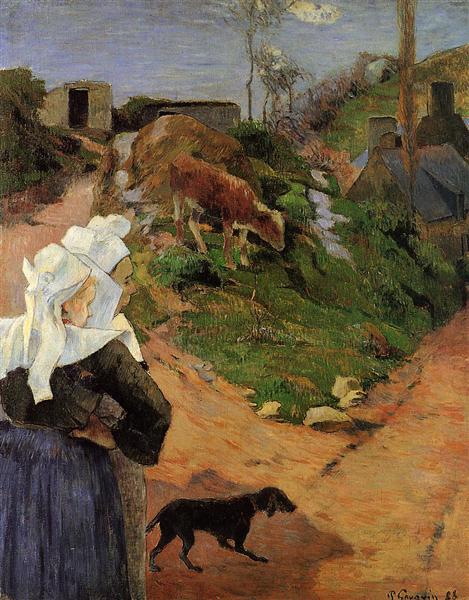Beskrivning
Paul Gauguin's "Breton Women at the Turn" (1888) is a sharp and nostalgic reflection of rural life in Brittany, where the artist channeled her unsettling fascination with the cultures and customs she encountered during her stay in the region. In this painting, Gauguin freezes a moment of stillness and reflection in the lives of Breton women, surrounding them with an environment that is both real and symbolic. This work sits at the intersection of verism and symbolism, characteristics that define Gauguin's style in this period of his career.
The composition of the work is an essential element to understand its visual impact. Two women, dressed in traditional Breton hats, dominate the foreground. Their central placement and the subtle superposition of their figures in an informality that seems almost intentional, allow the viewer to feel a strong emotional connection with the protagonists of this painting. Women are not just figures in the painting, they are bearers of a culture rich in traditions, symbolizing resistance and local identity in the face of the transformations of time.
The use of colour is equally significant. Gauguin employs a palette of earthy tones that enlivens the work, whilst accentuating the almost mystical nature of the setting. The backgrounds are designed with a bold use of space, shades of green and brown that not only act as context, but also translate the calm atmosphere emanating from the scene. Each stroke of paint feels deliberate, contributing to a sense of flatness that defies conventional perspective; in this work, Gauguin seems to be more interested in the emotionality of the scene than in its faithful representation.
One of the most fascinating aspects of Breton Women at the Turn is the way the work suggests a dialogue between the traditions of the past and the modernity that was seeping into Europe in the late 19th century. The attention to the women's clothing, rich in cultural detail, stands in stark contrast to the inevitable modernization that was beginning to influence the lives of rural communities. Gauguin, though influenced by Impressionism, moved away from its intricate techniques of light and color, seeking instead a more symbolic and artistic form of art that sought the soul of its subject, rather than simply its outward appearance.
The portrait of women in their environment has generated great artistic and intellectual interest, as it transcends the specific moment of the painting, resonating with the struggles of cultural identity that are still being experienced in many parts of the world. It shows a deep admiration for the strength and resilience of these female figures who, although they seem immersed in their own world, invite the viewer to explore their history and meaning.
This work by Gauguin can be compared to other works from his period, such as “Where do we come from? What are we? Where are we going?” from 1897, where the artist seeks to convey complex messages about the human condition through iconography and symbolism. With “Breton Women at the Turn,” Gauguin, with his introspective gaze, encourages us to reconnect with the traditions that have shaped us, using art as a means to explore what is to come, but which always carries with it the traces of what was. Thus, the work becomes not only a portrait of a time and a place, but a testament to the eternal search for cultural identity in a constantly changing world.
KUADROS ©, a famous painting on your wall.
Hand-made oil painting reproductions, with the quality of professional artists and the distinctive seal of KUADROS ©.
Painting reproduction service with satisfaction guarantee. If you are not completely satisfied with the replica of your painting, we will refund 100% of your money.

